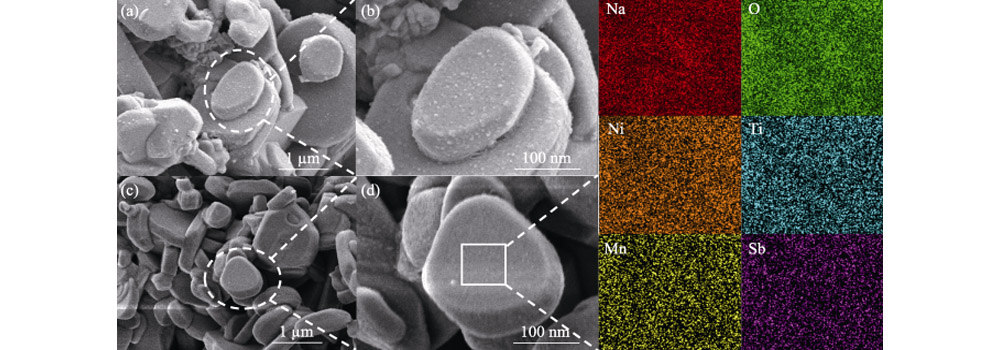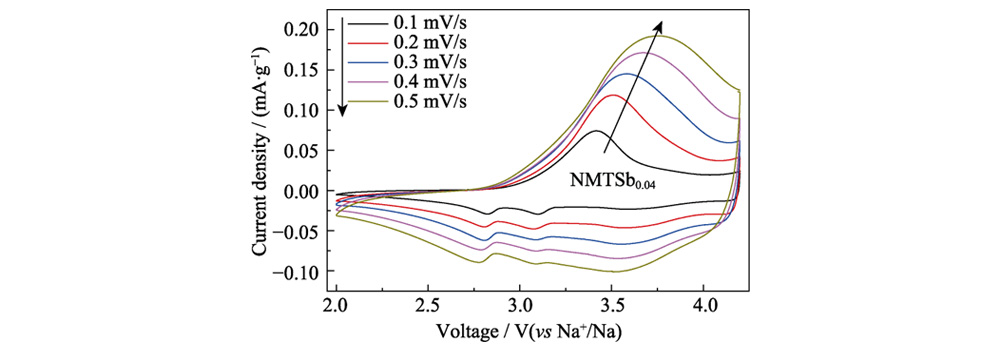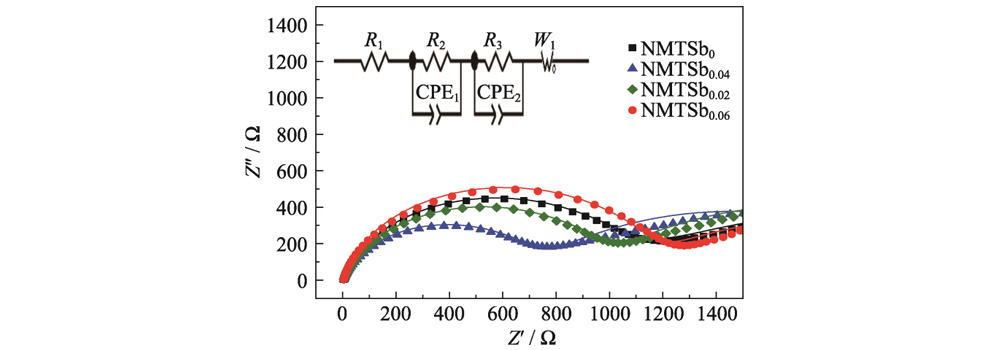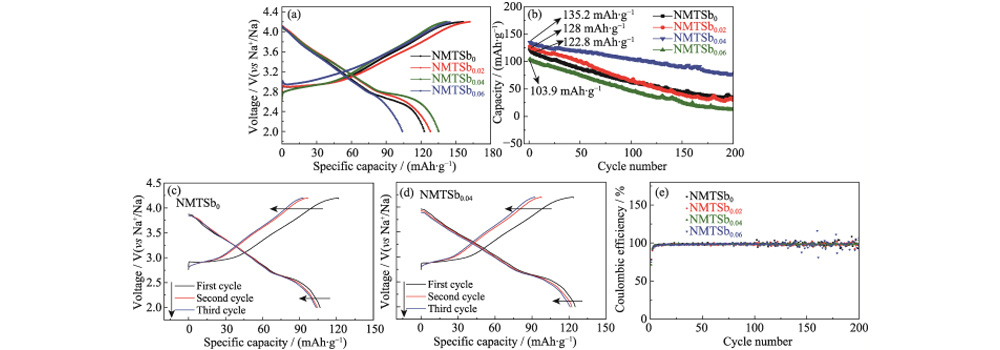Sb Doped O3 Type Na0.9Ni0.5Mn0.3Ti0.2O2 Cathode Material for Na-ion Battery
KONG Guoqiang, LENG Mingzhe, ZHOU Zhanrong, XIA Chi, SHEN Xiaofang. Sb Doped O3 Type Na0.9Ni0.5Mn0.3Ti0.2O2 Cathode Material for Na-ion Battery[J]. Journal of Inorganic Materials, 2023, 38(6): 656-662.
Abstract
Keywords: Sb doping; O3 type; cathode material; solid phase method; wide voltage; Na-ion battery manufacturing
Since the commercialization of lithium-ion batteries, they have been widely used in portable electronic devices, electric vehicles and electrochemical energy storage, etc. However, the limited resources and uneven distribution of lithium is an important factor restricting the development of lithium-ion batteries. At the same time, sodium reserves are abundant and widely distributed, and more importantly, due to the similarity of the chemical properties of lithium and sodium, the working principle of sodium-ion batteries is close to that of lithium-ion batteries. Therefore, the application of sodium-ion batteries in the field of large-scale energy storage has received great attention.
Cathode materials for sodium-ion batteries
mainly include transition metal layered oxides, polyanionic compounds, and
Prussian blue analogues. Among them, the layered oxide NaxTMO2 (TM refers to
transition metal, 0
Among the various O3-type NaxTMO2 materials that have been reported, NaxTMO2 containing Ni and Mn has attracted much attention because of its abundant Ni/Mn resources and high storage capacity. For example, O3-type NaNi0.5Mn0.5O2 has a high reversible capacity (133mAh g−1). Good rate performance (30C, 40mAh g−1) and long cycle life (70% specific capacity retention after 500 cycles at 3.75C). However, there are still some problems restricting its further development, such as unsatisfactory rate performance, complex phase transition during charge and discharge, and rapid capacity decay especially at high voltages of 4.1–4.5 V. Recent studies have shown that partial doping of other elements can effectively improve the reversibility of the phase transition. For example, Ti-doped Na0.9Ni0.4Mn0.4Ti0.2O2 has a more reversible O3-P3 phase transition between 2.5 and 4.2 V, higher specific capacity (197 mAh g-1), and more stable cycle performance. Fe-doped NaFe0.2Mn0.4Ni0.4O2 has a high reversible capacity (165 mAh g-1) and a stable phase transition (87% capacity retention after 200 cycles) in the range of 4.0-4.3 V.
In addition, Sb5+ doping can also improve the cycle stability and working voltage of cathode materials. In order to obtain a more stable material structure and superior rate performance in a wider voltage range for O3-type layered oxides. In this study, Sb5+ was partially substituted for Ni2+ in Na0.9Ni0.5Mn0.3Ti0.2O2 (NMT) by a simple solid-state method to study the effect of Sb doping on the electrochemical performance of layered oxides and the reversibility change of O3-P3 phase transition in a wide voltage range.
1 Experimental method
1.1 Material preparation
Na0.9Ni0.5-xMn0.3Ti0.2SbxO2 (NMTSbx, x=0, 0.02, 0.04, 0.06) materials were prepared by solid phase method. The specific steps are as follows: mix Na2CO3, NiO, Sb2O5, MnO2, and TiO2 in the corresponding stoichiometric ratio, and add an additional 5% mole fraction of Na2CO3 in consideration of the volatility of Na at high temperature. Grind it evenly with an agate mortar and use a tablet machine to make a thin disc of ϕ16 mm. Heat treatment at 950 °C in air atmosphere twice, each time for 12 h. The same procedure was used to prepare NMTSb0 without Sb2O5 starting material, and all samples were stored in a glove box for future use.
1.2 Battery Assembly
The active material NMTSbx, acetylene black and polyvinylidene fluoride (PVDF) were weighed at a mass ratio of 7:2:1, and an appropriate amount of N-methylpyrrolidone (NMP) was added to grind to obtain a uniformly mixed slurry. The slurry was coated on the surface of aluminum foil, and the surface loading of the active material in the electrode was about 2.5 mg cm-2. Vacuum-dried at 80 °C for 12 h, and then cut into small discs of ϕ12 mm with a microtome as the positive electrode. CR2032 button cells were assembled in a glove box filled with Ar gas (the volume fractions of water and oxygen were both lower than 1×10-6). Among them, the counter electrode is metal sodium sheet, the separator is glass fiber, and the electrolyte is 1 mol L-1 NaClO4 dibutyl carbonate + fluoroethylene carbonate solution (volume ratio 1 : 1).
1.3 Material Characterization and Testing
The X-ray diffraction (XRD) spectrum of the sample was tested using MiniFlex 600 (Rigaku, Japan, Cu Kα), and the crystal structure was further refined by Rietveld through the structural analysis system (GSAS + EXPGUI). The microscopic morphology and particle size of the samples were observed by JSM-7610F (JEOL, Japan) scanning electron microscope (SEM) and JEOL JEM-2100F high-resolution transmission electron microscope (HRTEM). The X-ray photoelectron spectroscopy (XPS) of the valence state of the elements was tested on an Escalab250xi spectrometer using AlKα achromatic X-ray source. The molar ratio of each element in the sample was analyzed by inductively coupled plasma optical emission spectrometer (ICP-AES, iCAP 6300). Charge and discharge measurements were performed at room temperature using a Land CT2001A battery test system between 2.0 and 4.2 V, and the electrochemical impedance spectroscopy (EIS) of the electrodes was measured using a CHI660E electrochemical workstation (CH Instruments).
2 Results and discussion
2.1 Structural features of NMTSbx
The elemental composition of all samples was determined by ICP-AES, and the results are shown in Table S1. Within the range of measurement error, the actual content of each metal ion is basically consistent with the design composition. In the XRD spectrum of Fig. 1(a), all samples have O3-type hexagonal α-NaFeO2 structure (space group R-3m), consistent with NaNi0.5Mn0.5O2 (JCPDS 54-0887). It is shown that the introduction of Sb into the NMT lattice does not change the intrinsic structure of the material. The process of preparing high-nickel layered oxide cathodes by the solid-state method will inevitably produce a small amount of residual inactive NiO components, and the literature shows that the impact of trace amounts of NiO on battery performance is negligible. In Fig. 1(b), the diffraction peaks of NMTSb0.02, NMTSb0.04, and NMTSb0.06 shifted to large angles, and miscellaneous peaks began to appear in NMTSb0.06. According to the Bragg equation (nλ=2dsinθ), the average grain size of the powder is qualitatively analyzed. where n is the order of diffraction, d is the average thickness (nm) of the grains of the sample perpendicular to the direction of the crystal plane, θ is the diffraction angle corresponding to the strongest diffraction peak, and λ is the X-ray wavelength (nm). The crystal plane calculation results show that the grain size of the sample decreases after Sb doping, which is related to the difference in the ionic radius of Sb (0.06 nm) and Ni (0.069 nm). According to Vegard's theorem, this also means that a solid solution reaction occurred during the formation of NMTSbx.

Fig. 1 Survey (a) and enlarged (b) XRD patterns of NMTSbx (x=0, 0.02, 0.04, 0.06)
Figure 2(a, b) shows the refined XRD Rietveld patterns of NMTSb0 and NMTSb0.04, and the detailed lattice parameters are shown in Table S2. It can be seen that the lattice parameters of NMTSb0.04 (a=b=0.29790 nm) are slightly reduced compared with the original NMTSb0 (a=b=0.29812 nm). This is also attributed to the fact that the ionic radius of Sb (0.06 nm) is smaller than that of Ni (0.069 nm), which is consistent with the XRD analysis. The c (c=1.608391 nm) of NMTSb0.04 was increased compared with that of NMTSb0 (c=1.600487 nm). The main reason is that the lattice parameter a/b is sensitive to the change of the (Ni/Mn/Ti/Sb)-O bond length of the layered structure basal plane, and the incorporation of Sb shortens the bond length. This causes the electrostatic repulsion between oxygen atoms in the continuous transition metal layer (Ni/Mn/Ti/Sb) to become larger, leading to an increase in c. Moreover, after calculation, the c/a of NMTSb0 and NMTSb0.04 did not change much, they were 5.36 and 5.39 respectively, both were greater than 4.99, indicating that the doped samples maintained a good layered structure.

Fig. 2 Rietveld refinement XRD patterns of NMTSb0 (a) and NMTSb0.04(b)
Figure 3 shows the SEM pictures of NMTSb0 and NMTSb0.04. Both products are composed of a large number of micro-nano-scale thin discs with uniform thickness and clear edges. Especially after Sb doping, the flake surface is smoother, and there is no lack of hexagonal flake structure with sharp edges and corners. Selected-area EDS elemental analysis of NMTSb0.04 shows that Na, O, Ni, Ti, Mn, and Sb elements are evenly distributed in the sample, which also proves that Sb elements have been successfully doped into the intrinsic structure of NMTSb0.

Fig. 3 SEM images and EDS mappings of NMTSb0 (a, b) and NMTSb0.04 (c, d)
The microstructures of NMTSb0 and NMTSb0.04 were further observed by HRTEM, and the results are shown in Figure S1. In Figure S1(a, c), the particles before and after Sb doping are connected or superimposed, and macroscopically appear as a sheet-like or approximately circular or polygonal structure. The HRTEM images of Figure S1(b, d) show the lattice fringes of the material, and the lattice spacings of NMTSb0 and NMTSb0.04 are 0.238 and 0.237 nm, respectively. Both correspond to the (101) crystal plane, and the effect of doping Sb on the lattice spacing is consistent with the XRD analysis results. The insets of Figure S1(b, d) are the spots of the selected area electron diffraction pattern (SEAD) of NMTSb0 and NMTSb0.04, which proves that the obtained NMTSb0 and NMTSb0.04 have good crystallinity.
The X-ray photoelectron spectroscopy (XPS) of Figure S2 shows the oxidation state results of Mn, Ni, Ti, and Sb elements in NMTSb0 and NMTSb0.04. In Figure S2(a), the two main peaks of NMTSb0 at 877 and 850 eV correspond to Ni2p1/2 and Ni2p3/2, respectively, and both belong to Ni2+ in the sample. The binding energy peak at 858.2 eV is a common satellite peak in Ni element. The Ni2p1/2 of NMTSb0.04 splits into two peaks, indicating that the introduction of Sb into the NMTSb0 lattice can reduce the number of outer electrons around Ni, resulting in a strong electron delocalization effect. Transition metals have more delocalized d orbitals, which can enhance the metal-metal interaction of MO6 side-sharing octahedra in the layered structure, thereby inhibiting the collapse of MO6 octahedrons and alleviating the side reactions of lattice oxygen and electrolyte. During the charge-discharge process, the structure of the layered oxide material becomes more stable, indicating that strong electron delocalization is beneficial to the structural stability of NMTSb0.04. For the Mn element, the Mn2p3/2 peak at 642 eV and the Mn2p1/2 peak at 652 eV in Figure S2(b) indicate the presence of Mn in the +4 valence state in both NMTSb0 and NMTSb0.04. The Mn2p3/2 peak at 643eV can be matched with the Mn3+ peak. The octahedral configuration of Mn3+ will be deformed, which is caused by ginger-Taylor distortion. The dissolution of Mn element will lead to a rapid decline in capacity, while Ti in NMTSb0.04 replaces part of Mn, and the reduction of Mn content can also stabilize the structural framework of the material, thereby inhibiting the rapid decline in battery capacity caused by the ginger-Taylor effect. The typical binding energy peaks of Ti2p1/2 and Ti2p3/2 at 457.3 and 453.1 eV for NMTSb0 in Figure S2(c) correspond to the stable +4 valence state of Ti. While the Ti2p1/2 and Ti2p3/2 peaks at 454.1 and 463.9 eV of NMTSb0.04 correspond to Ti in the +3 valence state. From the perspective of charge compensation, this is mainly due to the reduction reaction of Ti after the introduction of high-valence Sb5+. During the charge-discharge reaction, Ti4+ continued to exist in a stable form, which was verified in the cyclic voltammetry (CV) curve of NMTSb0.04, as shown in Figure 4. This also shows that the source of battery capacity has nothing to do with the Ti4+/Ti3+ redox pair. In addition, the binding energy peaks of NMTSb0.04 at 529–536 eV in Figure S2(d) confirm the presence of Sb.

Fig. 4 CV curves of NMTSb0.04 cathode material
2.2 Electrochemical performance
Figure 5 shows the electrochemical impedance Nyquist plot of NMTSbx. Among them, the semicircle in the middle and high frequency region represents the charge transfer resistance (Rct) between the electrolyte and the electrode, and the oblique line in the low frequency region represents the Warburg resistance caused by the diffusion of sodium ions. Fitting the equivalent circuit shows that the Rct of NMTSb0 and NMTSb0.04 are 1185.4 and 761 Ω, respectively. As the Sb doping content increases, the impedance of the sample also decreases. When x=0.04, the impedance of the sample reaches the minimum value. Further increasing the Sb doping content leads to an increase in impedance. When x=0.06, the impedance exceeds that of the NMTSb0 sample. Appropriate doping content can obtain the optimal metal interlayer spacing of the layered structure, ensure smooth electron transport channels, help to improve the dynamic characteristics of NMTSb0.04, and at the same time take into account the stability of the overall structure.

Fig. 5 Electrochemical impedance spectra of NMTSbx
Under the condition of current density of 1C (240 mA·g−1) and voltage range of 2.0-4.2 V, the sodium storage performance of the Na-ion battery with NMTSbx as the electrode was tested. As shown in Figure 6(a), the reversible capacities of NMTSbx (x=0, 0.02, 0.04, 0.06) samples are 122.8, 128.0, 135.2 and 103.9 mAh g−1, respectively. The difference in specific capacity is due to different doping content. The strategy of chemical element substitution can suppress the irreversible phase transition and improve the sodium ion transport kinetics. The advantages are summarized as follows: replace highly active elements with electrochemically inactive and structurally stable elements, such as preventing cation mixing by increasing the energy barrier of Ni2+ migration, and reducing the oxygen released during electrochemical cycling by strengthening metal-oxygen bonds. Doping or replacing transition metal sites can significantly inhibit the phase transition, inhibit transition metal ion migration, and improve the chemical and electrochemical stability of desodiumized materials. The specific doping content should be explored according to the type of doping element and the intrinsic structure. . On the one hand, doping with high-valent metal ions can improve the bulk conductivity of the material after the metal ions enter the interior of the lattice. When the mole fraction of doping is greater than 1% (stoichiometric ratio x>0.01), the resistivity will decrease rapidly, which will have a great influence on the conductivity. On the other hand, too high doping amount will inevitably reduce the content of redox couples in the system and affect the energy density of the system, while too little doping amount will not be enough to stabilize the structure of layered oxide materials. In this study, NMTSbx(x=0, 0.02, 0.04, 0.06), x is the stoichiometric ratio, and the actual doping content is 2%, 4% and 6% by mole fraction, respectively.

Fig. 6 Performance of Na-ion batteries with NMTSbx as electrodes
(a) Charging and discharging curves of Na-ion batteries with samples as electrodes for the first cycle at 1C; (b) Cycling performance of Na-ion batteries with samples as electrodes at 1C for 200 cycles; (c, d) Charging and discharging curves of Na-ion batteries with samples as electrodes for initial 3 cycles at 5C; (e) Coulombic efficiencies of Na-ion batteries with NMTSbx as electrodes for 200 cycles at 1C Colorful figures are available on website
In Fig. 6(a), the charge-discharge curve of the undoped sample NMTSb0 obviously contains multiple voltage plateaus and steps, indicating that multiple phase transitions from hexagonal to monoclinic may occur in the layered structure. However, while the interlayer slip of the transition metal layer occurs, the overall charge-discharge curve is relatively smooth. The three voltage platforms above 3.00 V tend to be blurred. For NMTSb0, the charging curve is mainly divided into two parts: the slope section around 3.00-3.80 V and the long plateau section above 3.80 V. However, when Sb was introduced, the initial voltage of the platform segment increased to above 4.00 V. For the discharge curve, the long plateau usually occurs in the voltage range of 2.50–2.75 V. The appearance of the voltage plateau can be attributed to the transformation of the O3 phase into the P3 phase, while the slope segment when the voltage increases is caused by the solid solution reaction with the P3 structure. Figure 6(b) is a comparison of cycle performance of NMTSbx (x=0, 0.02, 0.04, 0.06) electrodes at a current density of 1C. It is worth noting that the cycling stability of NMTSb0.04 cathode material is the best, and about 70% of the reversible capacity can be retained after 200 cycles. In contrast, the specific capacity of the NMTSb0 electrode decays very quickly, with an initial value of 122.8 mAh g-1, which drops to 51 mAh g-1 after 200 cycles, and only 41.5% of the specific capacity remains. In Fig. 6(c, d), even at a very high rate of 5C (1200 mA g−1), the specific capacity retention of the NMTSb0.04 electrode is still 92.6% (125.3 mAh g−1). The specific capacity of the NMTSb0 electrode is only 106.7 mAh·g−1, which is superior to other reported O3-type layered oxides. The initial discharge specific capacity of O3-Na(Ni1/3Mn1/3Fe1/3)0.95Al0.05O2 prepared by Yan's group at a rate of 0.1C is 145.4 mAh·g−1. And after 80 cycles at 0.2C rate, the reversible specific capacity is 128.4 mAh·g−1. The O3-NaNi0.5Mn0.5O2 prepared by Guo's research group has a specific capacity of 80 mAh·g-1 in the voltage range of 2-4 V at a rate of 2C. Figure 6(e) presents the Coulombic efficiency of the Na-ion battery during continuous cycling at 1C. Among them, the Coulombic efficiency distribution of the NMTSb0.04 electrode is stable and tends to a straight line, basically maintaining at 98%, which also indicates that its layered structure is more stable. However, the Coulombic efficiency of the NMTSb0 electrode fluctuated significantly after 140 cycles, and there was a large jump when it was close to 200 cycles. The battery assembled with NMTSb0.04 after 200 cycles was disassembled and processed, and the XRD spectrum of the electrode sheet was tested, the results are shown in Figure S3. The XRD diffraction peaks of the NMTSb0.04 pole piece did not shift significantly after cycling, indicating that the irreversible phase change of the NMTSb0.04 cathode material was suppressed after doping.
3 Conclusion
In this study, Na0.9Ni0.5-xMn0.3Ti0.2SbxO2 (NMTSbx, x=0, 0.02, 0.04, 0.06), a layered oxide cathode material for sodium-ion batteries, was prepared by a convenient solid-state method. Its particles are composed of micro-nano-scale flakes with uniform thickness and clear edges, and the grain size decreases after Sb replaces part of Ni. At the same time, the doping of Sb causes strong electron delocalization, which reduces the energy of the whole system and obtains a stable structure that is more conducive to long-term charge-discharge cycles. In the electrochemical test in the range of 2.00-4.20 V, the doping of Sb suppressed the irreversible phase transition of the cathode material and improved the working voltage platform. When charged and discharged at 1C rate, the initial discharge specific capacity of NMTSb0.04 is 135.2 mAh·g-1, and the capacity retention rate after 200 cycles is 70%. The specific capacity retention can reach 92.6% (125.3 mAh·g−1) at 5C rate.
Supplementary Information

Fig. S1 HRTEM images of NMT (a, b) and NMTSb0.04 (c, d) with inset in (b, d) showing corresponding SEAD images

Fig. S2 (a) Ni2p, (b) Mn2p, (c) Ti2p, and (d) Sb3d XPS spectra of NMTSb0 and NMTSb0.04

Fig. S3 XRD pattern of NMTSb0.04as cathode material of Na-ion battery after 200 cycles
Table S1 ICP-AES results of O3-NMTSbx (x=0, 0.02, 0.04, 0.06) (Stoichiometric ratio)
|
Na |
Ni |
Mn |
Ti |
Sb |
|
|
NMTSb0 |
0.913 |
0.486 |
0.288 |
0.181 |
0 |
|
NMTSb0.02 |
0.924 |
0.471 |
0.284 |
0.186 |
0.023 |
|
NMTSb0.04 |
0.920 |
0.452 |
0.287 |
0.184 |
0.039 |
|
NMTSb0.06 |
0.929 |
0.435 |
0.279 |
0.184 |
0.061 |
Table S2 Lattice parameters of materials with NMTSb0and NMTSb0.04
|
a/nm |
b/nm |
c/nm |
V/nm3 |
Rwp/% |
Rp/% |
|
|
NMTSb0 |
0.29812 |
0.29812 |
1.600487 |
0.1232 |
4.92 |
5.53 |
|
NMTSb0.04 |
0.29790 |
0.29790 |
1.608391 |
0.1236 |
5.65 |
6.32 |